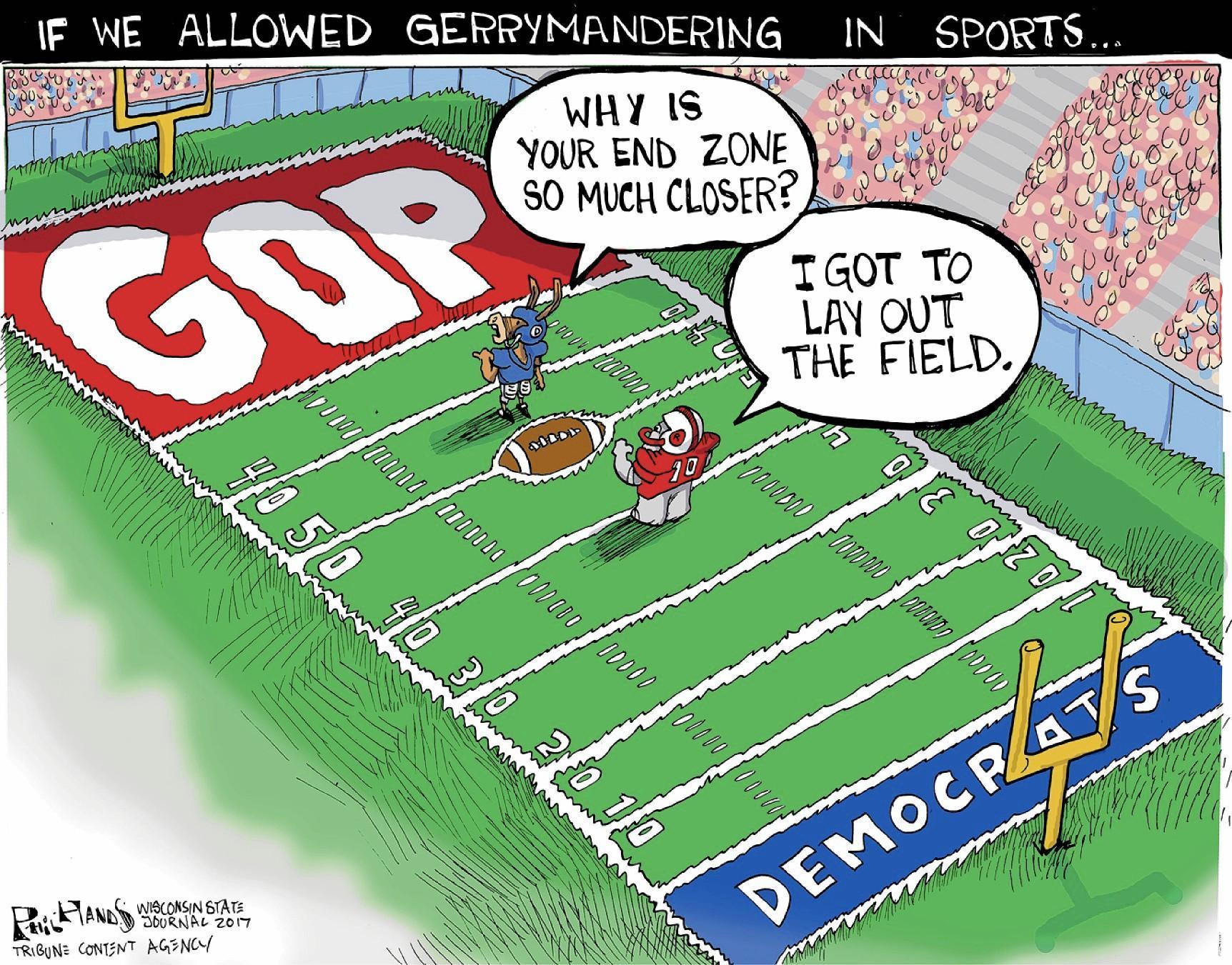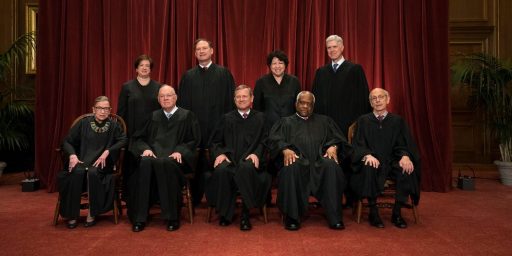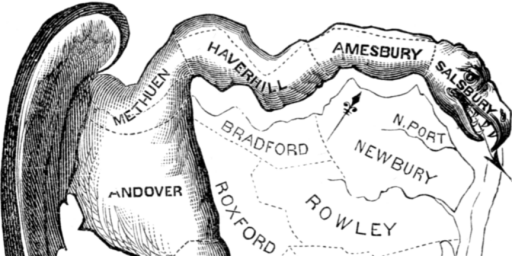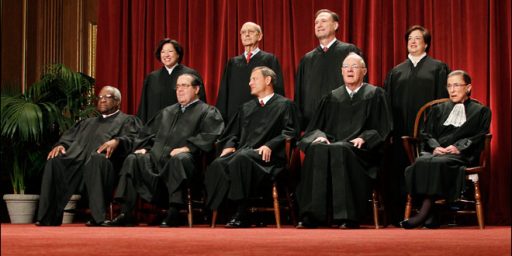Gerrymandering State Legislatures
Representatives Choosing Their Voters Rather than Vice Versa, Chapter 412.

Nick Corasaniti reports for NYT (“G.O.P. Cements Hold on Legislatures in Battleground States“) on a form of gerrymandering that gets far too little attention.
Republicans are locking in newly gerrymandered maps for the legislatures in four battleground states that are set to secure the party’s control in the statehouse chambers over the next decade, fortifying the G.O.P. against even the most sweeping potential Democratic wave elections.
In Texas, North Carolina, Ohio and Georgia, Republican state lawmakers have either created supermajorities capable of overriding a governor’s veto or whittled down competitive districts so significantly that Republicans’ advantage is virtually impenetrable — leaving voters in narrowly divided states powerless to change the leadership of their legislatures.
Although much of the attention on this year’s redistricting process has focused on gerrymandered congressional maps, the new maps being drafted in state legislatures have been just as distorted.
And statehouses have taken on towering importance: With the federal government gridlocked, these legislatures now serve as the country’s policy laboratory, crafting bills on abortion, guns, voting restrictions and other issues that shape the national political debate.
This is, of course, not new. Politicians have been drawing safe districts for themselves and their friends since time immemorial and, as party has become central to our politics, partisan advantage has become the main objective. But, as with many other things, intensification has occurred.
“This is not your founding fathers’ gerrymander,” said Chris Lamar, a senior legal counsel at the Campaign Legal Center who focuses on redistricting. “This is something more intense and durable and permanent.”
This redistricting cycle, the first one in a decade, builds on a political trend that accelerated in 2011, when Republicans in swing states including Pennsylvania, Wisconsin and Michigan drew highly gerrymandered state legislative maps.
Since those maps were enacted, Republicans have held both houses of state government in all three places for the entire decade. They never lost control of a single chamber, even as Democrats won some of the states’ races for president, governor and Senate.
Like it or not—and I don’t—this is perfectly legal. More than half a century ago, in Baker v Carr, the Supreme Court ruled that state-level districts have to be roughly equal in size (“one man, one vote”). And a whole series of rulings since have placed additional restrictions to ensure that race isn’t a predominant factor and requiring that districts be reasonably compact, contiguous, etc. But the basic idea that legislators can draw lines with the explicit intent of partisan advantage was upheld by the Supreme Court as recently as last year.
And, yes, “both sides” do it. It’s just that, for a variety of reasons, Republicans are more shameless about it.
All three of those Northern states are likely to see some shift back toward parity this year, with a new independent commission drawing Michigan’s maps, and Democratic governors in Wisconsin and Pennsylvania will probably force the process to be completed by the courts.
Gerrymandering is a tool used by both parties in swing states as well as less competitive ones. Democrats in deep-blue states like Illinois are moving to increase their advantage in legislatures, and Republicans in deep-red states like Utah and Idaho are doing the same.
But in politically contested states where Republicans hold full control, legislators are carefully crafting a G.O.P. future. They are armed with sharper technology, weakened federal voting statutes and the knowledge that legal challenges to their maps may not be resolved in time for the next elections.
Texas, North Carolina and Ohio have signed into law new maps with a significant Republican advantage. Georgia is moving quickly to join them.
One of the main factors here is one I noted in my last post: geographic sorting.
Republicans say that the growth of such heavily skewed legislatures is both the result of the party’s electoral victories and of where voters choose to live.
State legislative districts are by nature much smaller in population than congressional districts, meaning they are often more geographically compact.
As Democratic voters have crowded into cities and commuter suburbs, and voters in rural and exurban areas have grown increasingly Republican, G.O.P. mapmakers say that they risk running afoul of other redistricting criteria if they split up those densely populated Democratic areas across multiple state legislative districts.
“What you see is reflective of the more even distribution of Republican and right-leaning voters across wider geographic areas,” said Adam Kincaid, the director of the National Republican Redistricting Trust. Trying to draw more competitive legislative districts, he said, would result in “just a lot of squiggly lines.”
He pointed to maps in Wisconsin that were proposed by a commission created by Gov. Tony Evers, a Democrat. Under those designs, Republicans would still have a majority in both state legislative chambers (though with significantly smaller margins).
“They’re limited by geography,” Mr. Kincaid said. “There’s only so many things you can do to spread that many voters across a wide area.”
Both because of a genuine ideological commitment to a more representative system and because such a system redounds to their electoral benefit, Democrats have been at the forefront of taking the district-drawing power from state legislatures and giving it to ostensibly neutral commissions. But, of course, if one side is doing that and the other is doubling down on gerrymandering, the outcome is predictable.
Democrats note that Republicans are still cracking apart liberal communities — especially in suburbs near Akron and Cleveland in Ohio and in predominantly Black counties in northern and central North Carolina — in a way that helps the G.O.P. and cuts against a geographical argument.
“They are carving up Democratic voters where they can’t pack them,” said Garrett Arwa, the director of campaigns at the National Democratic Redistricting Committee. He argued that Democratic map proposals “all put forth better and more fair maps that I would say are far from a Rorschach test.”
Democrats have fewer opportunities to unilaterally draw state legislative maps, particularly in battleground states. Of the 14 states where the margin of the 2020 presidential race was fewer than 10 percentage points, Democrats are able to draw state legislative maps in just one: Nevada. Republicans control the redistricting process in six of those 14 states. (The rest have divided governments, or their maps are drawn by commissions.)
But, again, while Republican-controlled legislatures are rightly getting the most attention, they’re not alone.
But when Democrats have had an opening, they have also enacted significant gerrymanders at the state legislative level. In Nevada, Democrats are close to finalizing a map that would give them supermajorities in both chambers of the Legislature, despite President Biden’s winning just 51 percent of the state’s vote last year.
The same holds true in deeply blue states. In Illinois, newly drawn State Senate maps would give Republicans roughly 23 percent of seats in the chamber, even though former President Donald J. Trump won more than 40 percent of voters in the state in 2020.
It’s just that Republicans have more opportunity.
Republicans have taken two approaches to ensure durable majorities in state legislatures. The tactics in Texas and Georgia are more subtle, while Republicans in Ohio and North Carolina have taken more brazen steps.
In Texas and Georgia, the party has largely eliminated competitive districts and made both Republican and Democratic seats safer, a move that tends to ward off criticism from at least some incumbents in the minority party.
“Out of the 150 seats in the Texas House, only six of them are within seven points or closer,” said Sam Wang, the director of the Princeton Redistricting Project. Republicans now hold a 20-seat advantage in the chamber, 85 to 65, and the new maps will give the party roughly two more seats. So while the G.O.P. lawmakers did not try to draw an aggressive supermajority, “what they really did a good job of there is getting rid of competition and getting a reasonably safe majority for themselves,” Mr. Wang said.
To the extent there’s a solution to this problem—presuming you see it as a problem to begin with—it simply has to be national. Unless all the states play by the same set of rules, there’s no incentive for any legislature that can get away with it not to cheat their districting in their favor. It would amount to unilateral disarmament.
Since state legislatures, in turn, draw the lines for Congressional districts, Congress has an Article I authority to intervene here. Democrats are, of course, trying. But, not only would a Senate filibuster surely stop such a bill from passing but a handful of democratic Senators are squeamish about it.





I have said, ever since January, that there were problems with the big voting rights bills that would keep Schumer from getting 50+1 votes. The specific problem I point out is that the bills, at least as I read them, would require the increasing number of vote-by-mail states to reverse course and rebuild an expensive parallel precinct-based in-person voting system. When the state systems are ranked for security and accuracy by experts, the top five spots are dominated by vote-by-mail states — it’s the best system we know of. I wrote to my Senators and told them they ought to oppose the bill until the language was fixed to make it absolutely clear that it was okay for vote by mail states to have minimal in-person voting, not the expensive precinct system currently described.
To a great extent because the Billionaire Boys Club backed the Republican REDMAP project in 2010. They realized that they could put a lot of money into a relatively small number of state legislature swing seats, and if they could get a small majority, redistrict it into a large majority, in congress as well as in the state lege, and get a disproportionate return on their money. This is by way of returning to my theme that this stuff doesn’t just happen automatically because of out archaic rules. There are villains in the story.
These quotes contradict each other:
I used to live in Cincinnati, split down the middle to make two safe R districts.
Geographic concentration is a problem only when GOPs want it to be.
Digby has an interesting map. It’s a way to flip the usual red/blue, see, the whole country is red maps. It shows the biggest municipality in each state that voted for Trump in 2020. In Jame’s home state the largest city to go for Trump was Mechanicsville. Hoover AL, Bakersfield CA, Hialeah FL, West Seneca NY, Parma OH. In only a very few red states did a major city in the state vote for Trump.
@gVOR08:
The greater Republican opportunity for gerrymandering is overdetermined but, sure, there are monied interests pushing it. Mostly, though, it’s a twofold geographical issue:
1. Far more states are Republican-leaning than Democratic-leaning, even though there are far more Democrats than Republicans nationally.
2. Democrats tend to be concentrated in small areas (cities and inner suburbs) within the state. So, it’s simply easier for a Republican-majority legislature to manipulate the map to their advantage while staying within SCOTUS-decreed (but commonsensical) rules.
@James Joyner:
It was interesting that in the Wisconsin case that ended up at the SCOTUS, the Wisconsin Democrats conceded that there was a “natural” gerrymander because Democrat-leaning voters tended to be concentrated, and preferred not to have their cities split across districts. They put a numerical value on it: IIRC, that they would have to win the statewide total by about 7 percentage points to win half the seats in the state legislature.
Colorado’s shiny new redistricting commission did — at least IMO — a remarkably bad job. Despite enormous growth over the last 10 years, almost all in the Front Range urban corridor, and the addition of an eighth seat in the House: (a) all seven current representatives’ houses are in the new version of their district; (b) each of those districts is somewhat safer for those incumbents than it was; and (c) all the statewide offices are held by Democrats, Biden won Colorado by +14%, but there’s a good chance the new House delegation will be 4-4.
The Idaho GOP is absolutely awful in most ways, but they do not gerrymander the Idaho Legislature. We have a bipartisan redistricting commission here. In fact, it pitted many Republican incumbents against each other this year if the map holds u up. To the extent they win more seats than their share of the vote it is because single-member winner-take-all plurality districts are naturally gerrymandered as Stephen regularly discusses.
@IdaHokie: Steven not Stephen…sorry…it wouldn’t let me edit the post.
@gVOR08: WA! Until I saw the Digby map, I didn’t realize that Spokane Valley was a municipality now. When I lived there, it was 3 or 4 unincorporated areas.